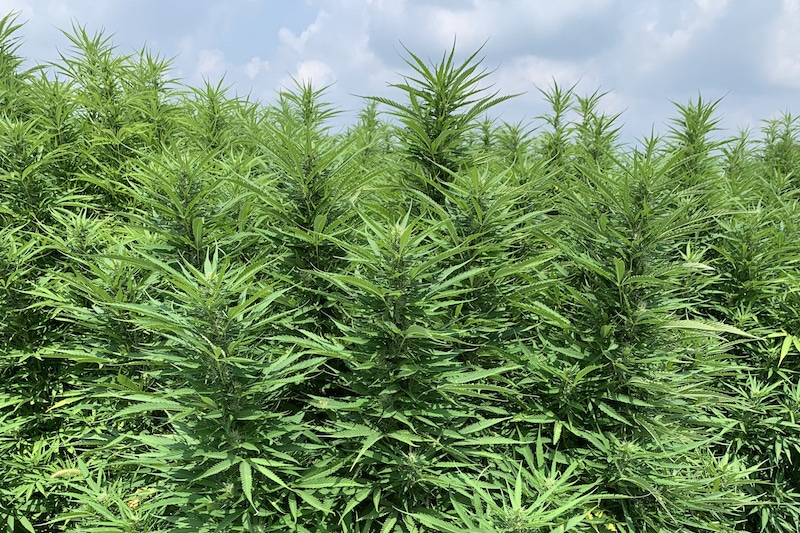
Addressing Plant Nutrition in Outdoor Hemp
Plant health is all about knowing what is in your water, soil and fertilizer, and finding the right balance of nutrients to produce the best crop possible.
GPN caught up with Krystal Snyder, a Penn State University Extension educator specializing in plant nutrition, to talk nutrient issues and how to fix them. She is based in northeast Pennsylvania, focusing on greenhouse floriculture, hydroponics, green industry and industrial hemp.
Snyder was a presenter during GPN’s inaugural Cannabis & Hemp Week.
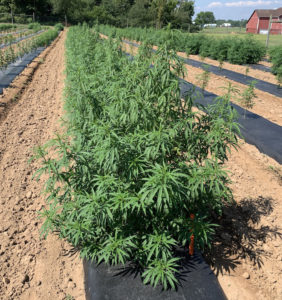
Why is plant nutrition important for outdoor hemp production?
Adequate plant nutrition reduces stress, it reduces disease, it reduces insect pressure — and really when it comes down to it, it’s putting money back in your pocket.
If you’re growing out in the field, I would definitely recommend getting a soil test because you don’t know exactly what’s in there, especially if you’re renting land or you haven’t farmed this field in a while. In outdoor growing, what the plants are growing in is so much more important than peat-based media in the greenhouse. We’re spending a lot of money to grow hemp per acre and then we’re inputting fertilizer that is also fairly expensive and if the soil pH isn’t right or maybe the nutrient balance isn’t correct in the soil, a lot of that fertilizer that you’re going to put on is not going to be available to those plants. So then we’re just kind of throwing money out the door.
What should growers watch out for when it comes to fertilizer?
[Growers] should make sure that all these fertilizers that they’re purchasing don’t have an excess of heavy metals in them. Hemp is an accumulator of heavy metals. So when we go to sell our end product — whatever we’re going to sell it for, biomass or for smokeable flower maybe — the buyer is going to want to know what the heavy metals are in that plant. So we want to make sure whatever fertilizers we’re purchasing are well under the recommended limit of heavy metals.
The other thing I would recommend for growers is to really look at the program that their fertilizer company is recommending and say ‘Hey do I really need all of these extra products? Maybe I only need two fertilizers for the season and I can come back and supplement them based on tissue testing.’
What are common nutrient deficiencies you have found in outdoor hemp?
CALCIUM
We see a lot of calcium issues in the field more than we would see them in a greenhouse situation because we are at the mercy of the humidity outside and the plants aren’t transpiring sometimes when it gets really hot and humid, so all that calcium that might be available, it’s just sitting in the soil. That’s something that people who grow in the greenhouse can see pretty quickly and they can change their airflow or they can reduce their humidity, but you can’t push more air through a field so that’s where knowing what the nutrients are is important. That’s the big thing I see for calcium — a lot of times its environmental more than a fertilizer situation because most fertilizers have calcium in them, it just gets tied up in the soil and the plants can’t utilize it.
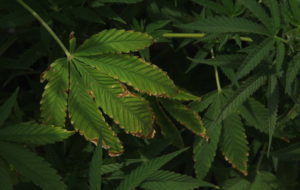
MAGNESIUM AND SULFUR
Magnesium and sulfur kind of go hand in hand. I do see magnesium issues a lot and that’s really because a lot of fertilizers don’t have ample amounts of magnesium in them. So if you look at, let’s just say a 20-20-20, which a lot of field growers are utilizing traditional horticultural fertilizers that maybe we would use in a greenhouse, but if you look at that label, you’ll see that sometimes there’s no magnesium and also no sulfur in that product. So it’s an essential element, it keeps our plants really nice and green and healthy and producing photosynthesis so if we don’t have that, we need to supplement it.
Most of our soils are lacking in calcium or magnesium and sometimes some micronutrients as well, but it’s very dependent on what soil type growers have.
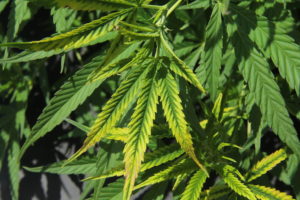
For sulfur, that was another one that there’s not a lot of it in water-soluble fertilizers. So if a grower is utilizing some pre-plant fertilizer and then also using a water soluble, they might not be getting that sulfur from anywhere and they would need to add that back in as well.
Check your fertilizer label. Make sure that there is some magnesium and sulfur in there. And if there’s not, think about using magnesium sulfate as a fertilizer drench or a fertilizer addition to kind of boost those numbers up, make your plants super nice and happy and green so that they can in turn put out the money makers of flowers.
How can growers identify these nutrient deficiencies?
There are some great visuals that you can see just by walking the crop. [Growers] should know what these deficiencies look like so they can take action … with changes in feed program or foliar applications.
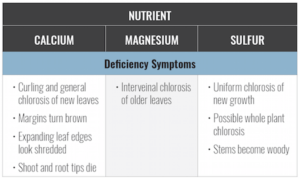
The other thing is using routine tissue testing — taking a sampling of the most recently matured new leaves and sending those in to a horticultural lab that will accept hemp tissues. We have ranges for those tissues now that we can put against what we get out from the lab and see where we need to problem solve. I always recommend that growers contact the lab first to make sure that they’re willing to accept the samples and then making sure that they are following what the lab wants — because the results are only as good as the sample that the lab gets. Utilizing tissue testing is how you can make changes on the fly with some good data-backed science and making sure that you’re getting the best bang for your buck.
Can tissue testing be used proactively?
Yes, some growers that I work with will test a couple times during the season so they can make changes before they see them in the plant. So what they’re seeing in the tissue, they’re like, ‘I know that we’re coming into flower soon and maybe I need an extra booster of potassium.’ So they can come back and get those [tissue] tests before they have a potassium deficiency. It’s really good to use these tissue tests, especially in an emerging crop, because we can find tune the fertilizer rates for different strains. So each strain has its little nuances, just like we see in other crops as well. And then we can really kind of tune that in and say well I know that I’m growing this strain from this genetics company and when I grew it in 2020, I had these problems or I had a whole lot of nitrogen and really could have used more potassium and then that will really help fine tune those for the next season coming up when growers are going to grow the same strains.
Learn how to monitor nutrition and how your choices can affect overall plant health by watching Snyder’s “The Nuts and Bolts of Plant Nutrition” presentation, now available on-demand at www.cannaproductnews.com/hemp/webinars. Plus, stay tuned for details on the 2021 Cannabis & Hemp Week, presented by GPN, Hemp Production News and Cannabis Product News.



